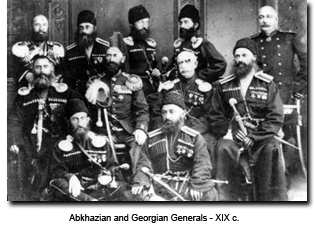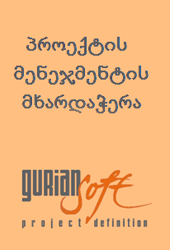Abkhazians
 Ancient Greek sources unequivocally indicate that in the 1st millennium B.C. the territory of present-day Abkhazia was part of the West Georgian Kingdom of Kolkhis, inhabited by Georgian tribes (Korakhi, Kols, Kolkhians and others), while the cities of Dioskuria (now Sokhumi) and Pitiunt or Pityus (now Bitchvitha) were in the area inhabited by Kolkhians.
Ancient Greek sources unequivocally indicate that in the 1st millennium B.C. the territory of present-day Abkhazia was part of the West Georgian Kingdom of Kolkhis, inhabited by Georgian tribes (Korakhi, Kols, Kolkhians and others), while the cities of Dioskuria (now Sokhumi) and Pitiunt or Pityus (now Bitchvitha) were in the area inhabited by Kolkhians.
Later on, in the 1st-2nd cc. A.D., Apshils and Abazgs believed by some scholars to be ancestors of the present-day Abkhazians are first mentioned as living on this territory. Apshils are, indeed, one of West Georgian tribes. As for the Abazgs, there are no sufficient grounds to regard them as direct ancestors of today`s Abkhazians despite the close affinity of the ethnic names "Abazg" and "Abkhaz". Later on, from the 4th c., these tribes, together with Missimians - a tribe of Svanian origin - were subjects of the Kingdom of Lazika/Egrisi that was established on the territory of ancient Kolkhis. Over the 4th-5th cc. all these tribal unions were under the cultural influence of their overlords who had embraced Christianity in the early 4th c.
Some Abkhazian researchers (Z.Anchabadze) put forward a hypothesis that the ethnic base of the Abkhazian Saeristhavo was "the unified Abkhazian ethnos that had resulted from consolidation of separate Abkhazian tribes and small nations". This hypothesis caused objections on the part of other scholars (N.Berdzenishvili, E.Khoshtaria-Brosset). Academician D. Muskhelishvili don`t agrees with it either, because the Early Feudal epoch did not offer any objective conditions, any pre-requisites for Abkhazian tribes to consolidate into a nation. These tribes did not have any tradition of statehood, of a state with a spoken and written language of its own; in other words, they did not have even the necessary minimum of the components that are required as a basis, as a pre-requisite of consolidation of any tribe or tribes into a nation. On the contrary, that period offered every condition for integration of all these tribes into a single Georgian people.
Thus, both neither in the Antiquity, nor in the Early Feudal epoch was historic Abkhazia an independent state, and Abkhazian tribes never had a statehood of their own. Abkhazia was a visceral part of Qarthvelian (Georgian) state formations - first Kolkhian, then Laz (Egrisi), later the so-called Abkhazian Kingdom and finally, from the close of the 10th c., it became part of the unified Georgian kingdom and until the late Middle Ages it remained as just another administrative unit like other Saeristhavos of Georgia. The involvement of the Abkhazians into the process of consolidation of the Georgian nation contributed to further integration of the Abkhazian tribes into the Georgian ethnic milieu. More on the history see: http://social.iatp.org.ge (History).
Regarding the problems of population. In the kingdom of the Abkhazians the Georgian ethnos proper formed an overwhelming majority, while the Abazgians and the Apshils (Abkhazians) - if consider a non-Georgian ethnos - represented the majority of the population. The presence of North-Caucasian tribes, e.g. a part of the Jiqi population, should be hypothesized in the Abkhazian Kingdom. This situation seems to have mainly preserved throughout the middle Ages, despite the later immigration of a considerable wave of the Apsua from the Northern Caucasus. This is confirmed by the data of census from the 19th century. 

According to the census of 1800 in Georgia were living 52,0 thousand abkhazians; in 1832 - 56,6; in 1865 - 60,0.
According to the lists of the 1886 Household census, in Abkhazia (Sokhumi district, by the administrative division of the period) the total of inhabitants were 68,773. Of these 34,806 were Georgians and 28,320 Abkhazians.
After this we have the census of 1926, according which the total of Abkhazia`s population was 201,016; of these Georgians - 67,494; Abkazians - 55,918; Armenians - 25,677; Russians - 12,553; Greeks - 14,045 and representatives of other nationalities.
According to the census of 1939, both the Georgian and Abkhazian population shows a corresponding growth. According to the latter census, the total population of the Abkhazian autonomous republic was 311,900 (Georgians - 91,900; Abkhazians 56,200; Russians 60,200; Armenians 49,700).
The census of 1959 gives the total of 404,700 for the Abkhazian autonomous republic: Georgians - 158,200; Abkazians - 61,200; Russians - 86,700; Armenians - 64,400 and others.
The census of 1970 shows the total of 487,040 inhabitants: Georgians - 199,600; Abkhazians - 77,300` Russians 92,900; Armenians - 74,900.
According to the census of 1989 in Abkhazia were living 239,9 Georgians and 93,3 Abkazians; Russians - 74,9; Armenians - 76,5.
The census of 2002 has not the data on the population within Abkhazia, however it shows that out of Abkhazia, in Georgian territory (including Kodori gorge) lived 3,527 Abkhazians.
Sources:
- M. Lorthqiphanidze, Essays of Georgian history, Tbilisi 1994, p.202;
- V. Jaoshvili, Georgia`s population, Tbilisi 1996, pp. 78-112, 282-302;
- Basic results of census of the Georgian population, Tbilisi 2002, vs. I - I






